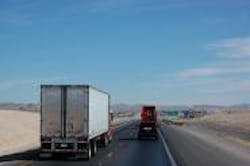“Rural roads are critically important to the success of our industry.” –Marvin Childers, president of The Poultry Federation
In the last of three reports compiled by the American Association of State Highway and Transportation Officials (AASHTO) dissecting U.S. transportation infrastructure needs, the group takes a hard look at situation faced by the rural areas of our nation.
This report – dubbed Connecting Rural and Urban America – of course calls for more investment in the transportation infrastructure serving America (for when do reports like this actually request LESS money, I ask you?)
Aside from that funding debate – and it’s a debate worth having – AASHTO’s research makes important points we should not soon forget about how important it is to make sure we maintain robust connections between rural and urban America. For example:
• Over 60 million people live in rural parts of the country – one out of every five Americans;
• In 2008, almost one out of eight people aged 65 and older lived in rural areas – equating to 9.6 million people;
• Some 66 cities with populations of 50,000 or more - including one state capital - do not have immediate access to the Interstate system;
• During the next 30 years, 80% of the nation's population growth is expected to concentrate in the South and West.
And let’s not forget something even more critical: Rural America is in many ways the “breadbasket” of the country as a whole. So getting the food its farms and other agricultural businesses produce to the urban tables where much of the U.S.’s populace resides requires solid transportation pathways.
Take Mississippi, for example – home to AASHTO President and Mississippi DOT Executive Director Larry L. "Butch" Brown.
Agriculture in Mississippi is approximately a $6.3 billion dollar industry, with over 42,000 farms covering 11 million acres or more. “In Mississippi, we're fortunate to have good waterways, ports, highways, and rail,” noted Brown. “But we must ensure that all rural states have good transportation options that will enable them to generate jobs and create strong economic growth.”
“Rural roads are critically important to the success of our industry,” said Marvin Childers, president of The Poultry Federation.
“Getting feed delivered to our farms and the chickens, turkeys and eggs delivered from the farms to our processing plants in a timely manner must take place for our industry to succeed,” he added. “Trucking is a critical mode of transportation for rural America. It carries 70% of agricultural and food products and provides the link between farmers, manufacturers, processors and markets. We cannot survive without a quality transportation system. Improving and keeping our transportation infrastructure in good repair is very, very important to the economy of this region.”
“The people who live in rural areas rely on commercial trucks, cell phones, and the Internet just as much as any city dweller,” AASHTO Executive Director John Horsley pointed out. “Yet many of our highways that serve rural areas were built back in the 1960s. Why do we expect our modern society to run on an archaic transportation system? We need a transportation system that works for the entire country of today – not one that struggles just to keep up with yesterday.”
That perspective, not surprisingly, is joined at the hip with a call for more spending on the transportation infrastructure serving rural America – and AASHTO’s report offers a three-point funding plan with those issues in mind:
• Continue to fund rural portions of the Interstate Highway System and other Federal-aid highways that connect America;
• Double federal investment in rural transit systems to meet rising demand; and
• Expand the existing capacity of the Interstate system; upgrade rural routes to Interstate standards; and connect newly urbanized areas to the Interstate system.
All of those ideas make sense, of course – if, that is, we weren’t dead broke as a nation, with $14 trillion in debt and federal government spending far exceeding tax revenues by about $1 trillion a year at this point.
The hard, cold facts of the transportation matter is that America can’t afford to invest what’s needed; unless, of course, we make drastic cuts in other areas of the bloated federal budget to pay for it. And that just doesn’t seem likely, at least anytime in the near future.
